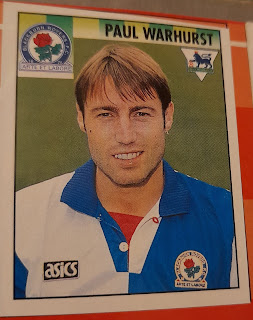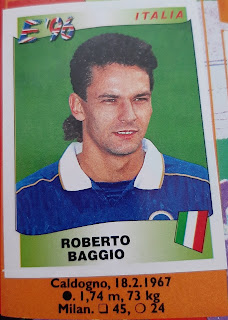63, Paul Warhurst, Blackburn Rovers, Merlin’s Premier League 95 Sticker Collection
Today Richard Allinson takes a look at a man who played in so many positions he probably had to keep some in his aunt’s house. As you will see versatility can be a blessing and a curse and its testament to today’s subject that he proved to actually be quite good wherever his managers decided to play him. He does lose a few marks for not taking a turn in goal, especially when he was at Crystal Palace and anything would have been better than Kevin Miller. But I digress. Over to Rich.
As a Grimsby Town fan, you get used to managers extolling the virtues of signing a ‘utility’ player. “He can play anywhere across the back! We can move him into midfield if that is how we want to set up! We brought him in because he’s equally capable in a number of positions!” What these managers have always omitted from their exclamations is that their latest signing is equally crap in a number of positions. However, there are some footballers out there that genuinely have the ablity to play in more than one area of the pitch. Take Dion Dublin for example. Or Chris Sutton. Or Paul Warhurst.
Warhurst started out his professional career as a defender with Manchester City, but having struggled to make the breakthrough at Maine Road he moved on to Oldham Athletic in 1988. Looking back on it now, it strikes me that the squad of players assembled by Joe Royle in that era was exceptional considering they were in the Second Division. I can’t think of many current Championship sides that would be able to put out a side as strong as one containing Denis Irwin, Mike Milligan, Neil Redfearn, Ian Marshall, Earl Barrett, Andy Ritchie and Paul Warhurst. That said even the most ardent Latics fan probably didn’t see the success of the 1989/90 season coming. Under Royle’s guidance they reached the 1990 League Cup final where they lost 1-0 to Brian Clough’s Nottingham Forest and featured in one of the most iconic weekends in FA Cup history. The 8th April 1990 saw Crystal Palace beat Liverpool 4-3 in a game that is so revered that Oldham’s 3-3 draw with Manchester United often goes under the radar, but having recently watched it back it is safe to say it was an equally enthralling game. Ultimately the Latics went on to lose the replay, but their cup exploits coupled with an eighth placed finish in the league was enough to bring the scouts (football, not Boy) down to the plastic pitch of Boundary Park and the following season was to be Warhurst’s last with Oldham as after 68 games and two goals he moved on to Sheffield Wednesday in the summer of 1991.
Warhurst joined the Owls for £750,000 (equalling their transfer record at the time) and initially took up a role in the Wednesday defence. However, following injuries to David Hirst (shock...) and Mark Bright during the 1992/93 season, Trevor Francis pulled the ultimate Sunday League trick and moved the big bugger at the back up front. All of a sudden Warhurst went from being a solid defender to being Marco van Basten as he banged in twelve goals in as many games. Although this is probably the most famous part of Warhurst’s career, it wasn’t all plain sailing. During a UEFA Cup match against Luxembourg minnows (is there any other type of Luxembourg side?) Spora, Warhurst collided with the opposition goalkeeper whilst scoring his second goal of the game. The collision would see him knocked unconscious for almost twenty minutes, swallow his tongue and turn blue. Thankfully the Wednesday physio was able to free his airways and after a short spell in hospital Warhurst was back in the Wednesday side and knocking in goals within a week.
His form would eventually earn him a call up to the England squad, albeit under Graham Taylor who gave pretty much anyone who owned a pair of boots a go. Unfortunately for Warhurst he didn’t make it onto the pitch for his national side due to injury but his reputation as a versatile player was cemented. He’d gone from being a right back with Oldham to a centre half and striker with Wednesday in no time. Except that it seems Paul didn’t really agree with the utility tag himself. Ahead of the 1993 FA Cup final, Wednesday manager Trevor Francis wanted Warhurst to return to his defensive role, a suggestion which Paul didn’t really fancy all that much because he believed he was now a striker. There seems to have eventually been some degree of bizarre compromise, Warhurst played in defence but wore number 9 and David Hirst started up front with number 5 on his back. I’m sure the Arsenal side were really confused by this move. For maybe about the length of the National Anthem. What this disagreement did mean though was that after 88 games and 18 goals, Warhurst’s Wednesday career was over. Having been placed on the transfer list by Francis, he was eventually snapped up by Blackburn Rovers for £2.7m as Jack Walker helped build a side ready for a tilt at the Premier League title.
When he signed for Blackburn, Kenny Dalglish had initially earmarked Warhurst for a role in Rovers’ midfield but only five games into his time with the club he suffered a double leg fracture which put him out for almost 12 months. After returning from injury, Warhurst found it difficult to hold down a regular place in the starting eleven but still appeared in over 20 games as the 1994/95 Premier League title race with Manchester United went to the wire. Unfortunately for Warhurst he suffered another leg break towards the end of the season and he was on crutches as the rest of the Rovers squad celebrated clinching the title at Anfield on the last day of the season. Despite his personal disappointment at not playing as big a role as he would have hoped, Warhurst has since described winning the title as a phenomenal experience. As a glory hunting Blackburn fan at the time, I can wholeheartedly agree with this assertion.
Warhurst’s relationship with Blackburn was to come to an end in the summer of 1997 as after 74 games and four goals he signed for Crystal Palace. After being with the Eagles for a year he moved to Bolton Wanderers for £800,000 following a successful loan spell. During his time with the Trotters he firmed up the midfield string to his utility man bow as he featured heavily in the middle of the park under Sam Allardyce. He stayed with Wanderers until 2003, helping them gain promotion to the Premier League in the 2000/01 season in the process and, from the end of his time in Bolton to the conclusion of his career, he then became somewhat of a journeyman. In the space of four years he played for ten different clubs (probably in ten different positions) before retiring in 2007 after seeing out his playing days with a couple of games for Northwich Victoria. From what I can work out he has stayed in the game following retirement, becoming an agent and a director at a sports management company but really there isn’t a lot more to add on that score.
So Paul Warhurst then, he won the Premier League, played in one FA Cup and two League Cup finals and got called up to the England squad. More importantly though, he is the man that proved that being a good utility player is actually possible.





Comments
Post a Comment